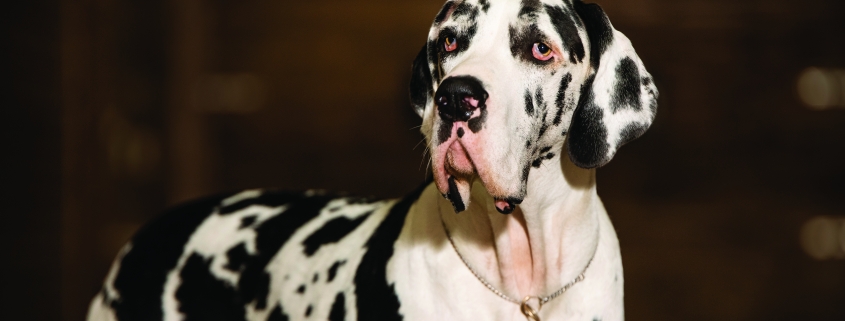BY CHERESE COBB, FREELANCER
“Great Danes are like having a toddler in a dog suit,” says Jennifer Klika, president of the Upper Midwest Great Dane Rescue in Eagan, Minn. “There are days I’d need a pitchfork to push my 9-year-old out of bed. Then he gets the zoomies and runs like a maniac for 15 minutes and looks like a camel whose legs are falling off.” With a lanky body and a head that doesn’t quite match, Danes pout when they want attention, slump when they’re disappointed and bounce when they’re happy.
History
Danes were originally bred to hunt boars. Assyrians, a major power in the ancient Middle East, traded them with the Greeks and Romans. They mixed them with Irish Wolfhounds, Irish Greyhounds and the ancestors of English Mastiffs.
By the 1500s, German nobility used Danes to protect their homes and loved ones. They considered the breed to be the biggest and most handsome of dogs, calling them Kammerhundes (Chamber Dogs). They were given gilded collars trimmed with fringe and padded with velvet.
In the 1700s, French naturalist Georges-Louis Leclerc de Buffon discovered a slimmer German Boarhound. He said the Danish climate caused it to become a Grand Danois (Big Danish). He didn’t develop the breed. But the name stuck.
Dane Mom For Life
After Victoria Burger’s Saint Bernard, Holly, passed away, she opened her home to three Danes. Finley’s former owners broke her jaw by pulling on her collar and punished her by yanking her ears. “Even if I’m not touching them, she’ll yelp because she has some nerve damage,” Burger says. “There are some holes in her training, but she’s still wonderful.”
Partly deaf and blind, Marlo weighed 38 pounds when he was pulled from a Texas backyard. “When he’s happy, he squints his eyes, smiles with his lips and wags his tail,” she says. Mooshie, who was purchased from a Canadian breeder, is stoic. “She makes a lot of eye contact. When we’re out walking—and she’s off-leash—she’ll stop, look back and wait,” says Burger.
Mooshie doesn’t nab chicken from the table or nip when children tug on her. “I have two horses, and she’s very respectful of them. She likes to kiss their noses,” Burger says. When Mooshie isn’t getting pawdicures every two weeks, she totes around her owner’s childhood teddy bear. “She’ll fall asleep with it in her mouth. He’s got like a duct tape diaper on him because I’m tired of sewing him up,” she says.
In the summer, her Danes are up at 5:45 a.m. to go hiking and swimming. “Their activity level is influenced by mine. I walk them four times a day,” Burger says. “Danes don’t ignore you and are always in tune with you … I’ll never have another breed. I’m a Dane mom for life.”
Health
Danes live an average of 7 to 10 years. They’re prone to bone cancer, heart disease, hypothyroidism, ear infections and hip dislocation. “Digestion problems and allergies also are surprisingly high in Danes. My personal guy gets Benadryl during allergy season. Or he licks his little paws pink,” Klika says.
According to the Universities Federation for Animal Welfare (UFAW), 42 percent of Great Danes develop bloat during their lifetimes. Treatment consists of a gastropexy (or “pexy”), in which the dog’s stomach is sutured to the body wall, preventing it from twisting. “This procedure is recommended at the time of spay or neuter, as opposed to a second anesthetic event,” says Dr. Morgan McCoy from Magnolia Springs Veterinary Center in Sturtevant, Wis.
Should You Adopt a Dane?
Although Danes are gentle giants, they’re not for everyone. They hate being alone (so they may cope by eating 43 of your socks) and love to cuddle, even if that means suffocating you under their heft. Danes will follow you to the bathroom and scratch on the door if you “accidentally” lock them out. They slobber and lumber around in a rather bumptious manner. They might be afraid of cats, plastic bags or suspicious-looking rocks. But they’ll fill awkward silences with woofs, grunts and pitiful stares.


